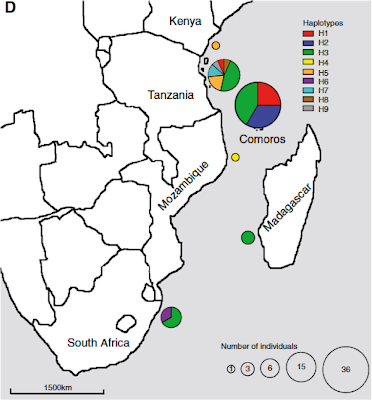The term 'living fossil' is a problematic one because its meaning is so frequently misunderstood. The greatest misunderstanding is that a living fossil species has not evolved for tens or even hundreds of millions of years (e.g. anatomically modern coelacanths are know from 409 mya). But, this is completely and utterly wrong. Living fossils are species that are related to, and superficially resemble, other species from the fossil record. But, they can be morphologically distinguished from the fossil species and have almost certainly evolved in ways that don't preserve in stone (e.g. behaviourally, physiologically and immunologically).
 |
| Three species of coelacanth. The top two are the fossil species Coelacanthus and Macropoma, while the bottom is the extant specie Latimeria. Note that they are all similar, but easily distinguished. |
The morphology of coelacanths has not fundamentally changed since the Devonian age, that is, for about 400 million years. Nevertheless, these animals known as living fossils are able to genetically adapt to their environment.There is nothing at all surprising about populations of living fossils containing enough genetic diversity to adapt to the environment. And there is simply no good reason to assume that their genetic diversity will be any different to any other extant species.
The paper itself does not make this mistake. The interesting thing about studying the genetic diversity of coelacanths is not because they are living fossils, but because they are considered rare and endangered. A good understanding of genetic diversity within populations and an understanding of gene flow among populations can be very informative for the development of conservation management strategies. And this is the aim of the paper.
The authors obtained genetic material from 71 adult coelacanths from 6 locations across the entire known range of Latimeria chalumnae, the East African coelacanth (L. menadoensis is a second species found off Indonesia). The genetic diversity among the coelacanths was low, as would be expected from their small population sizes. The largest population of 300 - 400 individuals occurs off the Comoros Islands and all other populations appear to derive from it. The greatest genetic diversity, however, was found in populations from Tanzania.
The genetic differentiation between the Comoros population and populations in other locations shows that adaptation is still occurring, but that there is unlikely to be much gene flow among populations. Interestingly, and completely unexpectedly, there appears to be two genetically distinct populations occurring at the same locations within the Comoros Islands. It's unclear what factors are driving the differentiation in the two Comoran subpopulations.
The genetic differentiation between the populations along the African coast isn't strong. This suggests that either the populations diverged relatively recently, or that they're evolving slowly. Curiously, the authors argue that their results confirm that the coelacanths are evolving slowly. But, their data can't separate these two hypotheses. Other studies show that the genes which control morphology are evolving slowly (surprise!), but other gene regions are within the evolutionary rates for vertebrates and consistent with rates in sharks, which have similar life histories. It seems more likely, therefore, that the populations have diverged relatively recently, suggesting that populations could be being recolonised from the Comoros Islands after local extinctions.
So, coelacanths, like other living fossils, are evolving just fine. Their populations off East Africa look to have reasonably good genetic diversity for their population numbers. But, populations will probably need to be managed separately because there is little gene flow among them.
Reference:
Lampert KP, Fricke H, Hissmann K, Schauer J, Blassmann K, Ngatunga BP, & Schartl M (2012). Population divergence in East African coelacanths. Current biology, 22 (11) DOI: 10.1016/j.cub.2012.04.053

No comments:
Post a Comment
Note: Only a member of this blog may post a comment.